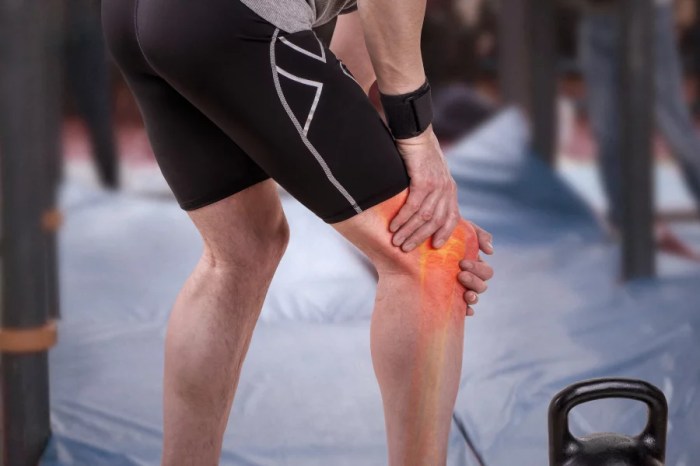Exercise for Chronic Pain Management: A Guide to Relief and Wellness

Exercise for chronic pain management is a powerful tool for improving quality of life. While it may seem counterintuitive to move when you’re in pain, exercise can help alleviate discomfort, increase mobility, and boost overall well-being. This guide explores the benefits of exercise for chronic pain, providing practical advice and resources to help you embark on a personalized journey toward pain relief and improved health.
Chronic pain is a complex condition that can significantly impact daily life. While pain medication and other medical interventions may be necessary, exercise plays a crucial role in managing pain and promoting overall health. By understanding the relationship between chronic pain and physical inactivity, we can unlock the potential of exercise as a valuable tool for improving quality of life.
Understanding Chronic Pain and Exercise

Chronic pain is a complex condition that can significantly impact a person’s quality of life. While rest is often recommended in the initial stages of pain, prolonged inactivity can exacerbate pain and contribute to a vicious cycle. Understanding the relationship between chronic pain and physical inactivity is crucial for developing effective pain management strategies.
The Relationship Between Chronic Pain and Physical Inactivity
Chronic pain often leads to physical inactivity as individuals try to avoid activities that trigger or worsen their pain. This inactivity, however, can have several negative consequences. Reduced physical activity can lead to muscle weakness, decreased flexibility, and joint stiffness, all of which can further contribute to pain and disability.
Moreover, inactivity can negatively impact mental health, leading to depression, anxiety, and social isolation.
Benefits of Exercise for Chronic Pain Management
Despite the initial discomfort, exercise can be a powerful tool for managing chronic pain. Regular physical activity offers numerous benefits for individuals with chronic pain, including:
- Improved Muscle Strength and Endurance: Exercise strengthens muscles, improves joint stability, and reduces pain by increasing the body’s ability to absorb shock and support joints.
- Enhanced Flexibility and Range of Motion: Exercise can help improve flexibility and range of motion, reducing stiffness and increasing mobility.
- Pain Reduction: Exercise releases endorphins, natural pain-relieving chemicals, and can help reduce pain perception. It can also improve blood flow to the affected area, promoting healing and reducing inflammation.
- Improved Sleep Quality: Regular exercise can improve sleep quality, leading to increased energy levels and better pain management.
- Reduced Stress and Anxiety: Exercise can reduce stress and anxiety levels, which can contribute to chronic pain.
- Improved Mood and Cognitive Function: Exercise can boost mood and cognitive function, improving overall well-being and increasing a person’s ability to cope with chronic pain.
- Weight Management: Exercise can help manage weight, which can be beneficial for individuals with chronic pain, particularly those with conditions like arthritis.
Types of Chronic Pain Conditions That Can Be Managed with Exercise
Exercise can be beneficial for managing various types of chronic pain conditions, including:
- Arthritis: Exercise can improve joint mobility, reduce pain and inflammation, and strengthen muscles supporting the affected joints.
- Back Pain: Exercise can strengthen back muscles, improve posture, and reduce pain by improving spinal stability.
- Fibromyalgia: Exercise can help improve sleep quality, reduce pain and fatigue, and improve mood and cognitive function.
- Headaches and Migraines: Exercise can help reduce the frequency and severity of headaches and migraines.
- Neck Pain: Exercise can strengthen neck muscles, improve posture, and reduce pain.
- Osteoporosis: Exercise can help improve bone density and reduce the risk of fractures.
- Peripheral Neuropathy: Exercise can help improve blood flow to the affected nerves, reducing pain and numbness.
Types of Exercise for Chronic Pain Management

Exercise can be a powerful tool for managing chronic pain. It can help improve flexibility, strength, and endurance, which can all contribute to pain reduction. However, it is important to choose the right type of exercise and to start slowly and gradually increase intensity.
Low-Impact Exercises
Low-impact exercises are a great option for people with chronic pain because they put less stress on joints. These exercises are typically performed at a lower intensity and do not involve jumping or high-impact movements. Examples of low-impact exercises include:
- Walking
- Swimming
- Cycling
- Water aerobics
- Yoga
- Tai chi
Strength Training
Strength training is important for managing chronic pain because it helps build muscle mass, which can support joints and reduce pain. This training can be done with weights, resistance bands, or even your body weight. Examples of strength training exercises include:
- Squats
- Lunges
- Push-ups
- Rows
- Bicep curls
- Tricep extensions
Flexibility Exercises, Exercise for chronic pain management
Flexibility exercises can help improve the range of motion and reduce muscle stiffness, which can contribute to pain relief. Examples of flexibility exercises include:
- Stretching
- Yoga
- Pilates
Specific Exercises for Different Pain Conditions
The type of exercise that is most appropriate for you will depend on your specific pain condition. Here are some examples of exercises that can be helpful for different types of chronic pain:
Back Pain
- Low-impact exercises: Walking, swimming, cycling
- Strength training: Plank, bird dog, back extensions
- Flexibility exercises: Cat-cow pose, hamstring stretches, spinal twists
Arthritis
- Low-impact exercises: Walking, swimming, water aerobics
- Strength training: Water weights, resistance bands, bodyweight exercises
- Flexibility exercises: Gentle stretching, yoga, tai chi
Fibromyalgia
- Low-impact exercises: Walking, swimming, cycling
- Strength training: Light weights, resistance bands, bodyweight exercises
- Flexibility exercises: Gentle stretching, yoga, tai chi
Individualizing Exercise Programs
It is important to individualize exercise programs based on pain levels, limitations, and goals. Working with a physical therapist or other healthcare professional can help you create a safe and effective exercise program. They can help you:
- Assess your current pain levels and limitations
- Develop a personalized exercise program
- Monitor your progress and make adjustments as needed
Remember to start slowly and gradually increase the intensity and duration of your exercise program. Listen to your body and stop if you experience any pain. With consistent effort, exercise can be a valuable tool for managing chronic pain.
Exercise Principles for Chronic Pain Management

Chronic pain management through exercise requires a careful and considered approach. It’s crucial to understand the principles of gradual progression and recognize your body’s signals, as well as the importance of proper form and technique. These principles are essential for maximizing the benefits of exercise while minimizing the risk of further injury.
Gradual Progression and Listening to Your Body
Gradual progression is a fundamental principle in exercise for chronic pain management. It involves starting slowly and gradually increasing the intensity, duration, and frequency of exercise over time. This allows your body to adapt to the demands of exercise without overwhelming it. Listening to your body is equally important.
Pay attention to any pain or discomfort you experience during exercise. Pain is your body’s way of telling you something is wrong. It’s essential to differentiate between pain that signals a need to stop and pain that can be tolerated.
Differentiating Pain Signals
- Pain that signals a need to stop: This is sharp, intense pain that worsens with activity and persists even after resting. It may be accompanied by swelling, redness, or heat. This type of pain usually indicates an injury and requires immediate attention.
- Pain that can be tolerated: This is a dull, aching pain that may increase with activity but subsides with rest. It’s usually a sign of muscle soreness or stiffness, which is normal after exercise. However, if this pain is severe or persistent, it’s essential to consult with a healthcare professional.
Proper Form and Technique
Proper form and technique are crucial for preventing further injury and maximizing the benefits of exercise. When performing exercises, focus on maintaining good posture and using the correct muscles.
Benefits of Proper Form and Technique
- Reduced risk of injury: Proper form and technique help distribute the load evenly across your joints and muscles, reducing the risk of strains, sprains, and other injuries.
- Enhanced exercise effectiveness: Using the correct form and technique ensures that you are targeting the intended muscles and getting the most out of your workouts.
- Improved pain management: By reducing the risk of injury and maximizing exercise effectiveness, proper form and technique can contribute to better pain management.
Designing an Exercise Program for Chronic Pain
Creating a personalized exercise program is crucial for managing chronic pain. This program should be tailored to your individual needs and pain levels, considering your specific condition and overall health. It is essential to work closely with a healthcare professional or physical therapist to ensure the program is safe and effective.
Setting Realistic Goals
Setting realistic goals is essential for long-term success in chronic pain management through exercise. This involves understanding your current limitations and gradually increasing the intensity and duration of your workouts.
- Start small and gradually increase the intensity and duration of your workouts. For example, if you can only walk for 5 minutes without pain, aim to increase that by 1 minute each day.
- Focus on improving your functional fitness, such as being able to walk further, climb stairs, or reach for objects.
- Celebrate your progress and acknowledge your achievements, no matter how small they may seem.
Monitoring Progress
Monitoring your progress is crucial for ensuring that your exercise program is effective and safe. This involves tracking your pain levels, activity levels, and overall well-being.
- Keep a pain diary to record the intensity, duration, and location of your pain before, during, and after exercise.
- Track your exercise sessions, including the type of activity, duration, and intensity.
- Monitor your overall well-being, including your mood, energy levels, and sleep quality.
Consulting a Healthcare Professional
Consulting a healthcare professional or physical therapist before starting a new exercise program is crucial. They can assess your condition, recommend appropriate exercises, and provide personalized guidance.
- A healthcare professional can help you identify the underlying cause of your chronic pain and develop a treatment plan that addresses your specific needs.
- A physical therapist can teach you proper exercise techniques, modify exercises to suit your limitations, and provide support and encouragement throughout your journey.
- Working with a healthcare professional or physical therapist can help you stay motivated and prevent injury.
Benefits of Exercise for Chronic Pain Management
Exercise can be a powerful tool for managing chronic pain. It not only helps to improve physical function but also offers a range of psychological benefits that can significantly enhance quality of life.
Improved Mood and Reduced Stress
Regular physical activity can have a profound impact on mood and stress levels. Exercise triggers the release of endorphins, natural mood boosters that have pain-relieving effects. It also helps to reduce levels of stress hormones like cortisol, which can contribute to pain and anxiety.
Studies have shown that exercise can be as effective as antidepressants in managing mild to moderate depression.
Reduced Inflammation
Chronic pain is often associated with inflammation, a process that involves the body’s immune system. Exercise can help to reduce inflammation by improving blood flow and circulation, which allows for the delivery of oxygen and nutrients to tissues. It also promotes the removal of inflammatory byproducts.
Research has shown that exercise can be particularly beneficial for reducing inflammation in conditions like arthritis.
Increased Strength and Flexibility
Regular exercise can help to increase muscle strength and flexibility, which can improve posture, balance, and overall mobility. Stronger muscles can help support joints and reduce pain, while increased flexibility can help to improve range of motion and reduce stiffness.
This is particularly important for people with chronic pain, as it can help prevent further injury and improve their ability to perform daily activities.
Improved Sleep
Chronic pain can often lead to sleep disturbances. Exercise can help to improve sleep quality by promoting relaxation and reducing stress levels. Regular physical activity can also help to regulate the body’s natural sleep-wake cycle. It’s important to avoid exercising too close to bedtime, as this can make it harder to fall asleep.
Increased Energy Levels
It might seem counterintuitive, but exercise can increase energy levels in people with chronic pain. While exercise can be tiring at first, it can help to improve overall fitness and reduce fatigue in the long run. Exercise can also help to boost metabolism and improve blood flow, which can lead to increased energy levels.
Research Findings
Numerous studies have demonstrated the effectiveness of exercise in managing chronic pain. For example, a 2017 study published in the journal “Pain” found that exercise was more effective than medication in reducing pain and improving function in people with chronic lower back pain.
Another study, published in the “Annals of Internal Medicine,” found that exercise was as effective as anti-inflammatory drugs in reducing pain and improving function in people with osteoarthritis of the knee.
Increased Sense of Well-being
Beyond the physical benefits, exercise can also have a significant impact on mental well-being. Exercise can boost self-esteem, improve body image, and increase feelings of control over one’s health. It can also provide a sense of accomplishment and purpose, which can be particularly beneficial for people living with chronic pain.
Safety Considerations for Exercise with Chronic Pain

Exercise is an important part of managing chronic pain, but it’s essential to prioritize safety to avoid exacerbating pain or causing injuries. Understanding potential risks and taking precautions can help you enjoy the benefits of exercise without compromising your well-being.
Importance of Proper Warm-up and Cool-down Routines
A proper warm-up gradually prepares your body for physical activity, increasing blood flow to muscles and joints, improving flexibility, and reducing the risk of injury. Conversely, a cool-down helps your body recover by lowering your heart rate and reducing muscle soreness.
- Warm-up: Start with light cardio, such as walking or slow jogging, followed by dynamic stretches that mimic the movements of your exercise routine. For example, if you’re planning to do squats, include lunges and leg swings in your warm-up.
- Cool-down: After your workout, engage in gentle stretches, holding each stretch for 15-30 seconds. Focus on stretching the muscles you worked on during your exercise session.
Staying Hydrated and Avoiding Overexertion
Staying hydrated is crucial during exercise, as it helps regulate body temperature, lubricate joints, and transport nutrients to muscles. Overexertion can lead to pain flare-ups and injuries, so it’s important to listen to your body and stop if you experience any discomfort.
- Hydration: Drink plenty of water before, during, and after your workout. Aim for 8-10 glasses of water daily, and increase your intake if you’re sweating heavily.
- Overexertion: Start with shorter exercise sessions and gradually increase duration and intensity as your body adapts. Pay attention to your pain levels and stop if you experience any sharp or worsening pain.
Potential Risks and Precautions
Exercise can exacerbate pain in some individuals, especially during the initial stages of an exercise program. It’s important to be aware of potential risks and take precautions to minimize discomfort and prevent injuries.
- Pain Flare-ups: Exercise can sometimes trigger pain flare-ups. If you experience a sudden increase in pain, stop the activity and rest. Consult with your doctor or physical therapist to adjust your exercise routine.
- Overuse Injuries: Engaging in excessive exercise or performing repetitive movements can lead to overuse injuries, such as tendonitis or bursitis. It’s essential to listen to your body and avoid overdoing it.
- Pre-existing Conditions: Individuals with certain pre-existing conditions, such as arthritis or osteoporosis, may need to modify their exercise routines. Consult with your doctor or physical therapist to determine safe and effective exercises.
Resources and Support for Chronic Pain Management: Exercise For Chronic Pain Management

Managing chronic pain can be challenging, but you are not alone. There are numerous resources available to help you navigate this journey, including websites, organizations, support groups, and professional services. This section will explore these resources and highlight the importance of building a supportive network.
Websites and Organizations
Numerous websites and organizations provide valuable information and resources for individuals with chronic pain. These resources can offer guidance on understanding chronic pain, exploring treatment options, and connecting with others who share similar experiences.
- The American Chronic Pain Association (ACPA): This organization provides information, support, and advocacy for people living with chronic pain. They offer resources such as educational materials, support groups, and a helpline. Their website, [Website URL], provides comprehensive information on chronic pain, treatment options, and ways to get involved.
- The National Pain Foundation (NPF): The NPF is a non-profit organization dedicated to improving the lives of people with chronic pain. Their website, [Website URL], offers information on pain management, treatment options, and resources for patients and their families. They also provide a directory of pain management specialists and support groups.
- The National Institutes of Health (NIH): The NIH is a government agency that researches chronic pain and other health conditions. Their website, [Website URL], provides information on chronic pain research, treatment options, and clinical trials.
- The Pain Management Resource Center (PMRC): The PMRC is a website that provides information and resources on pain management, including treatment options, self-management techniques, and pain relief strategies. Their website, [Website URL], is a valuable resource for anyone seeking information on chronic pain management.
Support Groups
Connecting with others who understand the challenges of living with chronic pain can be incredibly beneficial. Support groups offer a safe and supportive environment to share experiences, exchange information, and find emotional support.
- Online Support Groups: Numerous online support groups are available for individuals with chronic pain. These groups can provide a platform for connecting with others from around the world who share similar experiences.
- Local Support Groups: Many communities offer local support groups for individuals with chronic pain. These groups can provide a chance to connect with people in your area and build relationships with others who understand your struggles.
Physical Therapy and Other Professional Services
Physical therapy is an essential component of chronic pain management. These can help you develop a personalized exercise program, improve your strength and flexibility, and teach you pain management techniques. Other professional services that can be helpful for chronic pain management include:
- Occupational Therapy: Occupational therapists can help you adapt to your pain and improve your ability to perform daily activities.
- Massage Therapy: Massage therapy can help relieve muscle tension and improve blood circulation, which can be beneficial for chronic pain.
- Acupuncture: Acupuncture is a traditional Chinese medicine practice that involves inserting thin needles into specific points on the body. It is believed to stimulate the body’s natural healing mechanisms and reduce pain.
- Pain Management Specialists: Pain management specialists are physicians who specialize in the diagnosis and treatment of chronic pain. They can help you develop a comprehensive pain management plan that addresses your individual needs.
Building a Supportive Network
Having a supportive network of friends, family, or healthcare professionals can significantly impact your chronic pain management journey. A supportive network can provide:
- Emotional Support: Sharing your experiences and feelings with supportive individuals can help you cope with the emotional challenges of chronic pain.
- Practical Assistance: A supportive network can provide practical assistance, such as helping with errands, transportation, or household tasks.
- Accountability: Having a supportive network can help you stay motivated and accountable for your pain management goals.
Closing Summary
Incorporating exercise into your chronic pain management plan can be a transformative journey. Remember, it’s essential to listen to your body, start gradually, and seek guidance from healthcare professionals. With dedication and the right approach, you can experience the profound benefits of exercise in reducing pain, improving function, and enhancing your overall well-being.
Take the first step towards a healthier and more fulfilling life by embracing the power of movement.
Comments are closed.